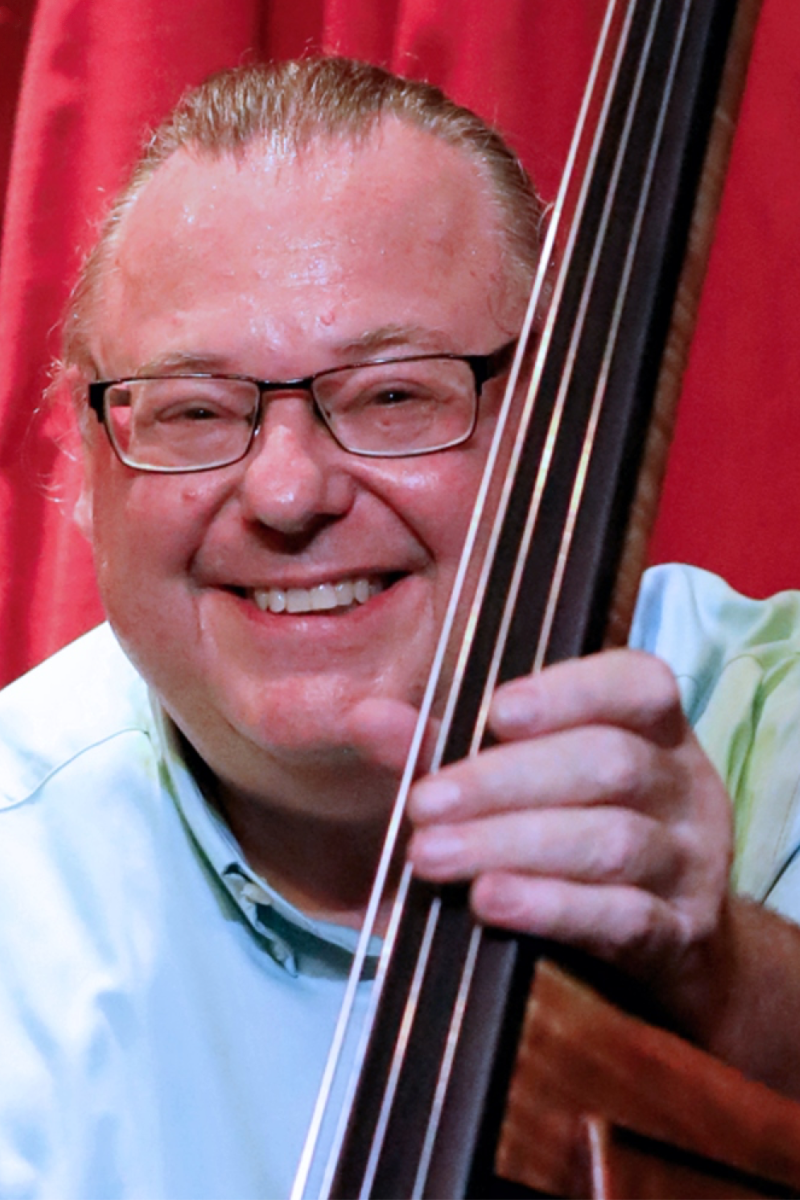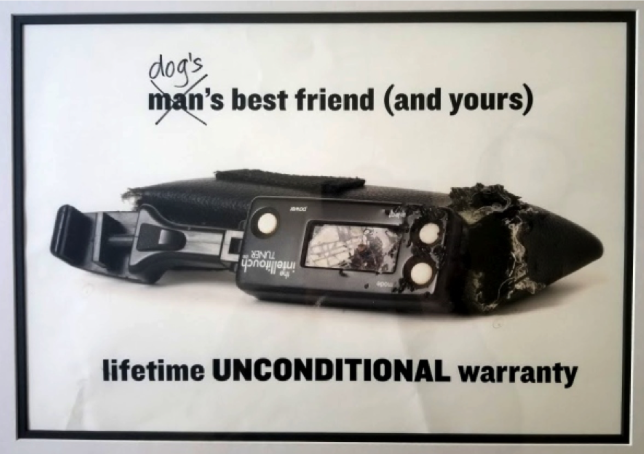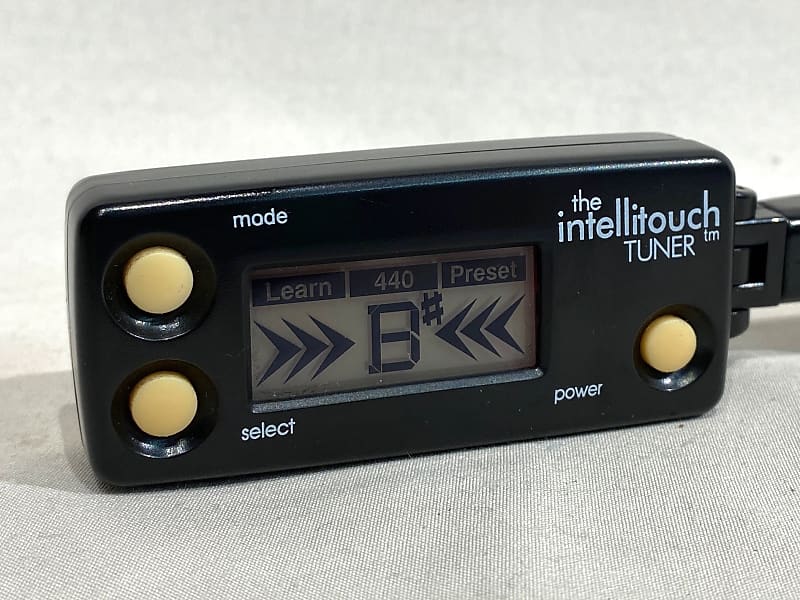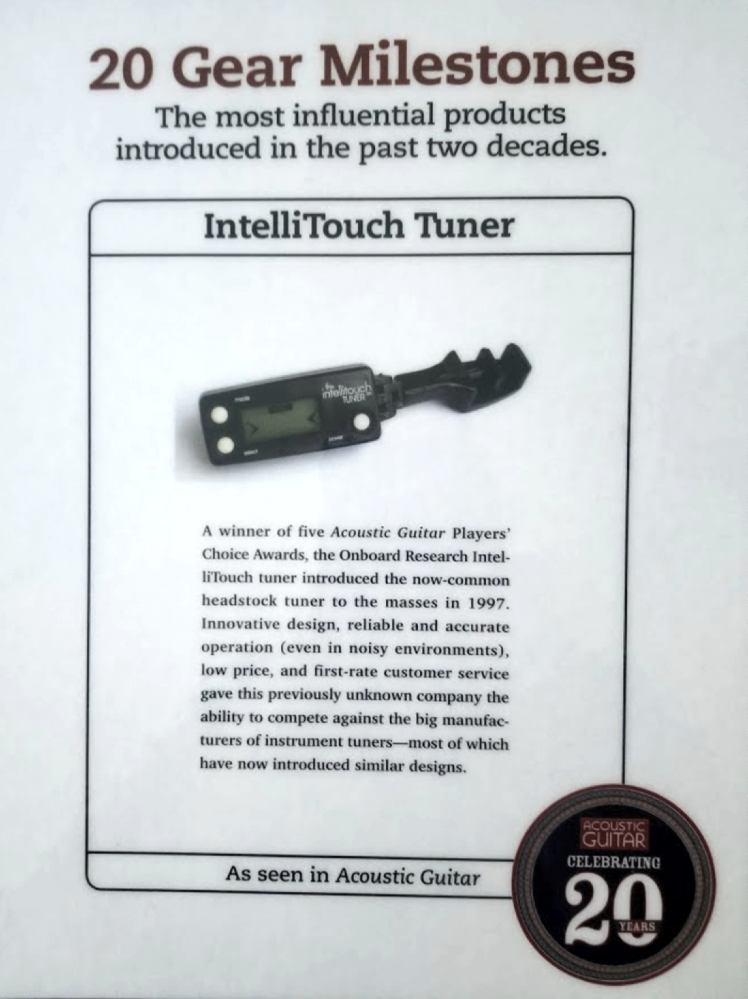A mandolinist is on stage with an acoustic band. He looks down at an inexpensive, small display clamped to the headstock of his instrument, and in minutes he is in perfect tune with no need for a pickup, microphone, amplifier, or cables. This is common for countless musicians now, but it was unheard of before 1997.
Mark Wilson is a professional musician residing in the Dallas area. His career has lately been a bit crimped by the Covid virus, which has "really twisted everything around," he says. Being a pro musician is the very definition of "a living"—it's a career that can take all you've got, and you could easily be "poor all the time." Mark is friendly, hard-working, opportunistic, visionary, and can be very tenacious about an idea.
Decades ago, Mark put these traits together to create the first clip-on tuner with the Intellitouch PT1. While companies like Boss and Korg had found success shrinking tuner technology down to handheld or pedalboard-friendly sizes, no one had thought to create a tuner that could detect vibrations directly from an instrument’s headstock. It would take Mark years of false starts and slow progress, before landing on a product that set the template for so many tuners available today.
Mark's Early Gigging and Entrepreneurial Days
Mark grew up in St. Louis and developed skill at playing bass guitar. At the age of 20, the union offered him a six-night-a-week country gig. Despite being completely unfamiliar with country music, he took it anyway, as it meant a steady paycheck. He worked that job for eight months, recalling it fondly as "a kick."

By age 27, he was still playing every night, but had moved to supper clubs through five steadily working bands. One day, when he was replaced in a band by a formally trained musician, Mark realized he needed to get educated in music if he wanted long-term success. So, in 1980, he moved to Denton, Texas, to start a jazz education curriculum, and began working in the local Dallas music scene.
About the time he graduated in 1983, he met an alto sax player named Spud Curtis. They would wind up playing Dixieland music together in Dallas for years—and becoming business partners.
Spud was very outgoing. A jazz player, he would walk into a dark heavy rock club, unpack his sax, and jump up onstage to join the surprised rock band. Spud also had a big effect on Mark, and had a saying that Mark adopted: "I'm just going at it like I knew what I was doing."
In 1984, Spud had become a partner in a computer equipment company. This was a high-growth business in the early '80s, and Dallas was a tech hotbed. Mark started hanging with Spud and his partner Phil Matthews at their office. Here, he first observed the entrepreneurial mindset in action.
With hardly more than a business card, a letterhead, and a lot of time on the phone, Phil and Spud were making money with their ideas. Mark was intrigued by these methods and began himself to entertain larger ideas, as his musician's paycheck was sometimes a bit modest. The entrepreneurial bug had bit him.
From Schecter to Startup
By 1985, the Schecter Guitar Research had relocated to Dallas (after a group of Texas investors purchased the brand), and Mark had made an appointment there to order a new bass. The sales manager casually expressed the need for Schecter to offer an in-house active pickup. Seeing an opportunity, Mark formed a plan to establish a company to provide these pickups. Not being technical, he planned to contract out the detailed design and manufacturing.
He contacted Schecter's then-owner, Clark Schwartz, directly, and proposed this. But Clark turned out to have a more urgent need: an inexpensive tuner that could be built into a guitar. Mark was fine with working on a tuner: "A tuner was just as easy to do as a pickup, because I didn't know anything about either of them!" He told Clark he would get back to him.

Mark needed an engineering perspective, so he contacted North Texas University (now UNT), where he had gone to school. He was referred to Dr. Russ Pinizzotto, a specialist in materials characterization and musical acoustics. Mark told him he needed his help to make a million dollars; Russ laughed and said to come on by. The two agreed that Schecter should be able to pay for the product development—they noted that Clark drove a Porsche, after all. At one point, Russ remarked that they could use a suction cup on the guitar and "suck" the music right out of it.
This particular partnership failed to assemble the talent to complete a design, and the deal with Schecter fell through, but Mark was now fixed on the idea of a vibration-based tuner. Such a tuner would be immune to room noise and would not require a cable, so any instrument could use it. It should have an edge over the traditional, non-contact, "mic and plug" handheld tuners from Korg, Seiko, and Roland.
As John Lennon sang, "Life is what happens to you while you're busy making other plans." Mark carried on through the next couple of years, working on identifying and developing major computer-related projects for Spud and Phil's company. Through it all, he was thinking about the tuner idea—and that it might have the potential for the kind of work he would really want to be doing.
He eventually met an electrical engineer by the name of Earl Born through another entrepreneurial venture. (Mark had convinced Phil to form a partnership to lease a Cessna aircraft to a local flight school. In return, they got free flying lessons and gained their licenses. They eventually decided to sell the plane, and Earl turned up as an interested buyer.)
Mark was always on the lookout for electrical engineers, so he filled Earl in on his tuner idea. Earl had a plan to build a printed circuit board shop in Mexico as a maquiladora, and he proposed designing the tuner if Mark would agree to let him manufacture it. Today, Mark describes Earl as "a little wise old elf," a real capable "backroom" kind of guy. Earl immediately asked Mark to borrow a guitar.
Earl found that the headstock was the best place to sample the vibrations. There were two reasons: First, the strings terminate there, so there is good mechanical coupling, and second, the small, rigid mass of the headstock does not resonate with room noise like the guitar body does.

Physics aside, Mark thought a tuner on the headstock was an aesthetically terrible idea, and he immediately began to think about how it could be made to look cooler.
Other key accomplishments came out of this period. Mark wrote up a detailed user's manual at Earl's behest ("So your engineers know when your product is working"). Mark also made a sketch of the tuning indicators, using three arrows on each side. Earl used the manual and sketch to create an elegant LCD segmented display. Mark, full of optimism, had 5,000 of the displays built at a local shop, gave Earl three of them, and stored the rest in his front hall closet.
Earl then built an electrical design around the display. With Earl's mechanical engineer friend Vic Moreland, they built three prototypes by hand. Although bulky and not productized at all, as Mark says, "they kinda sorta worked." The tuner idea was now real.
Getting Clip-Ons Off the Ground
In early 1990, Mark rented a booth at the NAMM show, where he demonstrated the prototypes, earned an endorsement from bassist and composer Michael Manring, and gained orders for 75 tuners. With all that, he finally had some tangible results, and figured he could leverage that into the rest of what he needed. And while he knew that the prototypes still needed major development to be ready for the market, he didn't know he was still years away from being able to deliver them.
Mark realized he was going to need capital to purchase the tuners from Earl, operate a shop, and hire employees. As luck would have it, Mark met Lynn Howard, a software programmer creating business planning software. They became friends, and Mark became an eager beta tester of Lynn's program, using it to experiment with hundreds of financial models. He learned the effects of different assumptions in the financial statements that the program produced. Settling on the best one, he started to assemble a business plan to show to potential investors.
More time passed, and in 1991 Mark moved to Dallas proper. His new landlord, Bob Snyder, turned out to be a talented software engineer. Mark and Bob instantly became friends, being like-minded, single, and entrepreneurial. One day, Mark mentioned to Bob that he had an order for 75 tuners, which was a problem because the design wasn't anywhere ready to ship. Bob was intrigued and eventually said he could improve the code. Mark was hesitant to risk ruining the friendship—a good friendship is worth a lot, after all.
The user's guide and display came in handy to give Bob a good idea of what was required of the software. Bob looked around at the available microcontroller chips and settled on a Motorola 8-bit model.
Nowadays, pitch detection might commonly be done by digitizing the signal with an analog-to-digital converter, then doing the math—perhaps a Fourier transform—in a digital signal processor or DSP chip. But back then, these were prohibitively expensive. The only way to meet the cost target was to use an inexpensive serial microcontroller ("micro") and hopefully not much else.
Mark invested in development tools, and Bob developed the code, eventually writing six different versions for testing. Bob's design started with a piezoelectric crystal to detect the instrument vibrations, and the signal was amplified through two op-amp gain stages until it was a square wave, then sent to a general input pin on the micro. The micro then timed the intervals between zero crossings and kept track of how many of each length occurred, creating frequency "bins."
The pitch-detection algorithm, informally called a "ring toss," worked on the principle that the fundamental frequency will have the most common occurrence rate, the peg with the most rings. The signal is also transiently chaotic, as the guitar vibrates at the fundamental but also has the first and second, and all the other harmonics all ringing and changing—a moving target. The algorithm worked well despite its simplicity. Overall, Bob put 500 hours into the software, eventually creating six different versions for testing.
Mark invited musicians over to his apartment to try the versions out. The setup on the dining room table included a PC and lots of loose wires connecting a shoebox-sized emulator, with the LCD display connectors held together with rubber bands. Eventually, everyone agreed on the best version and the software was ready at last.
The micro had extra pins, so Bob used them to drive the LCD display segments directly, avoiding an extra LCD controller chip. The display had seven segments for the musical note, six for the arrows, and various other indicators for a total of 17 segments. Other than an op-amp, a battery, and some buttons, there was very little else to the electrical design. Mark now needed an electrical engineer to turn everything on the table into a battery-powered circuit inside a small plastic housing.
At the time, Mark didn't have an obvious source for the circuit board, plastics, and retail packaging. But he kept the faith. "There was a lot of down time in between waiting for the right people to show up. I had to keep the pilot light lit the whole time, while working on the next obstacle," he says.
Looking back, he said he was fortunate in that most every task he encountered required him to stretch, learn about new things, and develop new skills. For example, "At the start, I knew nothing about printed circuit boards, but I now understand the entire process. Don't let lack of knowledge be a deterrent—it is really an exciting preview of the things you will soon be learning!"
By "hanging out and listening," he followed his friend Spud's advice: "Pay attention and learn, and pretty soon you do know what you're doing."
During this time, Mark began approaching potential investors with his business plan. He spoke with Stanley Marcus of Neiman Marcus, John Justin of Justin Boots, and singer Charley Pride, each of whom expressed only passing interest.
The Final Piece
In December of 1995, with the displays still sitting in the front closet, Mark was playing a gig, as usual, this time at Merrill Lynch's Entrepreneur of the Year award event. During the evening, he watched Jerry Rogers, founder of Cyrix Corporation, a manufacturer of PC microprocessors, receive the award. Jerry was a visionary chip designer who had gone head-to-head against Intel and AMD in the microprocessor market. Intel had sued him nine times and lost each time. He had been on the cover of Forbes and seemed like a smart, approachable guy. Mark decided that he needed to give Jerry a call.

Jerry called him back, they set an appointment to meet at Cyrix' offices, and Mark showed him the prototypes and the business plan. Jerry was receptive to the tuner idea at once, and one year later he agreed to fund the rest of the development. With Jerry on board, a company was formed: OnBoard Research Corporation.
A Cyrix engineer was drafted to design the PCB, while Jerry brought in Clarence Zierhut to design the plastics. Clarence, who had designed handheld weapon props for the Star Wars movies, designed the tuner's plastics and the clamp according to Mark's concept, while deferring payment to help with cash flow on the project.
An operations expert, Rusty Membreno, joined the team to source parts, pay the bills, and get finished units out the door. Mark says, "Rusty always surprised me with how much he could get done in a day. He was like a machine." Rusty was key in driving the unit cost down from $25 originally to less than $5. With a $60,000 plastics mold and the production circuit board, the world's first clip-on vibration tuner was a true physical reality, and a marketable product.
In 1997, roughly 10 years after Mark's first discussion of tuners with Schecter, OnBoard had tuners ready to ship. Mark promptly went on the road to evangelize the product, dubbed the Intellitouch tuner, at trade shows and music festivals.
The company lost $250k in each of the first two years but made it all back at the end of four, when the product took off and sold well. In all, 2 million tuners were ultimately sold, an unqualified success. A particularly rich market was the bluegrass scene; at their festivals, players used to spend a lot of time just getting in tune. Mark was told, "You used to be able to tell the good players, who were in tune, from the bad ones, who weren't—not anymore!"
The company had about four years with basically no competition as the big music suppliers were watching and waiting to see if this tiny company's new product category would take off. And while OnBoard had a good run, the competition did finally come on strong.
At a certain point, there was disagreement on the purpose, future direction, and investment of the company, and Mark wasn't able to realize the new tuners he envisioned to keep the company's edge. So, reluctantly, he resigned and offered his stock for sale to the other partners. It was time to relax a little.
I asked Mark for some words of wisdom from his journey. He brought up the concept of the "master idea," a life-changing and therefore deeply compelling and long-lasting idea. It starts with "Wouldn't it be great if..." The idea comes with its corresponding question: How do I get this done? This big question answers itself if you ask enough little questions; you keep asking the next smaller question until you start to find answers. It's like your master idea has dropped breadcrumbs from the future and your task is to find them, and when enough are found, your master idea will simply fall in place. You must keep at it: Great questions take time to answer, and it is okay to let things float and stay unanswered for a while. But wherever you are and whatever your idea, there are breadcrumbs at your feet to find.
Mark has since been playing music nonstop—bass, mandolin, guitar and pedal steel. The tuner venture was worth it, and not just financially—Mark says he had the time of his life, and that his role was as if meant for him, a "big picture" guy, but augmented by a technical team to manage the many details.
In his past role, Mark attended many bluegrass gatherings telling the Intellitouch story. Someone there gifted him a mandolin, and he spent time learning to play it, eventually adding it to his other instruments. And he tunes it with an Intellitouch tuner.
About the author: George Biner is an electrical engineer, musician, and recordist who resides in Los Angeles.
